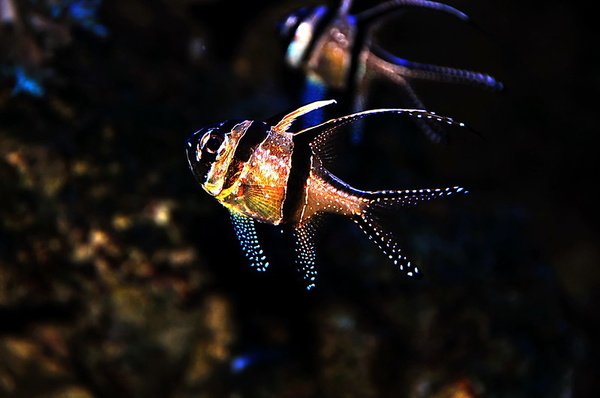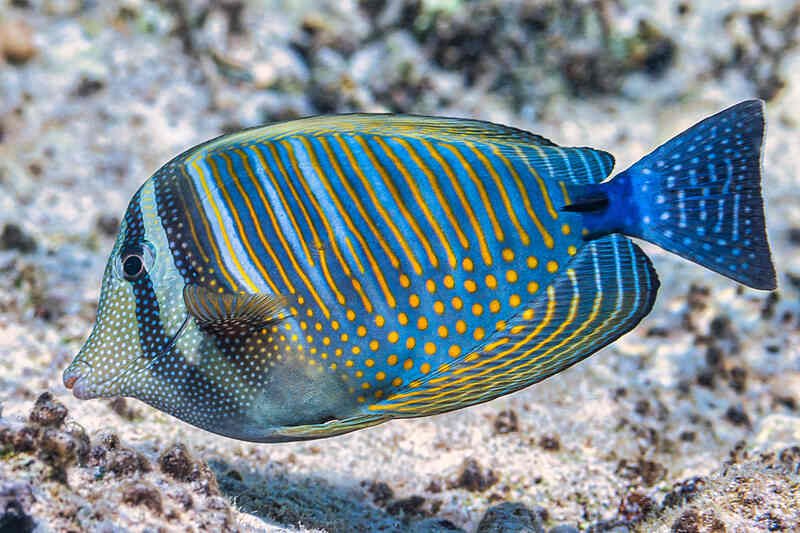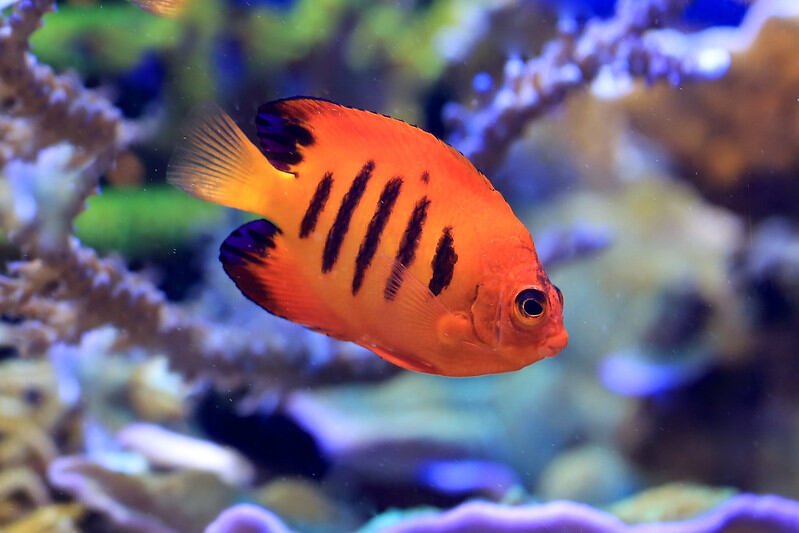Banggai Cardinalfish (Pterapogon kauderni) have always captured my interest, not only because of their striking appearance but also because of the story of their conservation. Keeping these elegant fish in an aquarium has been a rewarding journey, and through trial, research, and hands-on experience, I’ve discovered the essentials for their care.
In this blog, I will share everything I’ve learned about caring for Banggai Cardinalfish, from setting up a suitable habitat to managing their feeding habits, behavior, and breeding.
Banggai Cardinalfish: Why They’re Special
The Banggai Islands in Indonesia are home to the Banggai Cardinalfish. Their black-and-white-striped bodies, long flowing fins, and large eyes make them a popular choice among aquarists. Unfortunately, their wild populations have dwindled due to over-collection for the aquarium trade, but captive breeding has grown, offering a sustainable way to enjoy these beautiful fish.
I was drawn to their peaceful demeanor and stunning appearance when I decided to keep Banggai Cardinalfish. However, I quickly learned that these fish require specific care to thrive, and it’s essential to understand their needs before bringing them into a home aquarium.
Setting Up the Perfect Aquarium for Banggai Cardinalfish
Tank Size and Requirements
Banggai Cardinalfish may be small (reaching about 3 inches in adulthood), but they need space to feel comfortable. I recommend a minimum tank size of 30 gallons for a small group of 3 to 5 fish. This allows them enough space to establish territories without causing stress.
One of my early mistakes was housing them in a tank that was too small. They exhibited stress and aggression toward each other, especially between males. A larger tank not only reduced these problems but also gave them space to swim freely.
Aquascape and Environment
Creating a natural habitat is essential. In their native waters, Banggai Cardinalfish live among coral reefs and seagrass beds, so I aimed to replicate this by including live rocks, soft corals, and seagrass-like plants. Providing hiding spots, such as caves and crevices, was crucial because it gave them a sense of security.
In my experience, they tend to stay near the middle or bottom of the tank, preferring quiet zones. If the environment is too bare, they may become stressed or display erratic behavior.
Water Parameters
Maintaining stable water parameters is essential for these fish. Here are the parameters that worked best in my setup:
- Temperature: 75-80°F (24-27°C)
- pH: 8.0-8.4
- Salinity: 1.020-1.025 (specific gravity)
- Ammonia and Nitrites: 0 ppm
- Nitrates: Below 20 ppm
I monitor the water quality closely with a testing kit. Regular water changes—about 10-20% weekly—keep nitrates in check. Banggai Cardinalfish are sensitive to ammonia and nitrites, so cycling the tank before introducing them is non-negotiable.
Feeding Banggai Cardinalfish: What Works and What Doesn’t
Banggai Cardinalfish are carnivores, and they need a varied diet to stay healthy. I initially struggled to get them to eat, as they can be picky, especially when newly introduced to a tank. Here are the foods that I found worked best:
- Frozen Foods: Mysis shrimp and brine shrimp are favorites.
- Pellets: Small, high-quality marine pellets worked once they became more comfortable in their environment.
- Live Foods: In the beginning, I had the most success with live brine shrimp and copepods to stimulate their appetite.
They often refuse flake food, so I don’t recommend relying on it. It’s also essential to feed them small amounts multiple times a day. I’ve found that they prefer to hunt floating or slowly sinking food, mimicking how they feed in the wild.
Behavior and Compatibility with Other Fish
1. Peaceful but Territorial
One of the interesting things I’ve observed is that Banggai Cardinalfish are peaceful with most tank mates, but they can be territorial with their own kind. Males, in particular, may become aggressive toward one another if the group is too small or if there are too many males.
In my experience, keeping them in odd-numbered groups (such as three or five) helps reduce aggression. A pair will often bond and stay together, but in a group setting, there will always be some pecking-order behavior.
2. Tank Mates to Consider
When selecting tank mates, I’ve had success with the following species:
- Clownfish
- Firefish
- Gobies
- Soft corals and invertebrates like shrimp and snails
Avoid housing them with aggressive species like larger wrasses or tangs, as these can intimidate the Banggai Cardinalfish and cause stress.
Breeding Banggai Cardinalfish
One of the most exciting aspects of keeping Banggai Cardinalfish is the possibility of breeding them. They are one of the few saltwater species that are relatively easy to breed in captivity, and I was lucky enough to witness this process firsthand.
1. How to Encourage Breeding
Banggai Cardinalfish are mouthbrooders, meaning the male carries the fertilized eggs in his mouth until they hatch. To encourage breeding, I provided:
- A healthy diet of frozen and live foods to condition the fish.
- Calm tank conditions with plenty of hiding spots.
- A bonded pair—it’s crucial to have a compatible pair, as not all pairings will result in breeding.
2. Signs of Breeding Behavior
The first time I noticed breeding behavior, the male stopped eating and began carrying eggs in his mouth. It took me a while to realize what was happening, as I initially thought he was sick. He held the eggs for about 25 days before releasing tiny, fully-formed fry into the tank.
3. Caring for the Fry
Raising the fry was one of the most challenging aspects. They require a separate nursery tank to protect them from other fish. I fed the fry newly hatched brine shrimp and ensured the water quality was pristine.
Common Problems and How to Solve Them
1. Stress and Aggression
One fish being bullied is frequently an indication that the dynamics of the group aren’t functioning well. I solved this by adding more hiding spots and adjusting the group size.
2. Refusal to Eat
Banggai Cardinalfish may refuse food when they are first introduced to a new environment. Live food usually entices them, and after a few days, they become more accepting of frozen or pellet food.
3. Diseases
Like all fish, Banggai Cardinalfish are susceptible to diseases such as marine ich and fin rot. I quarantined new fish before introducing them to the main tank and kept a close eye on water quality to prevent outbreaks.
My Tips for Success
- Research Before Buying: Understanding their behavior and needs is crucial for success.
- Start with Captive-Bred Fish: Not only does this support conservation, but captive-bred fish are usually hardier.
- Be Patient with Feeding: It took time for my fish to get comfortable with new foods.
- Monitor Water Quality Closely: Stability is key to keeping these sensitive fish healthy.
- Enjoy the Process: Caring for Banggai Cardinalfish can be challenging, but it’s also incredibly rewarding.
Banggai Cardinalfish Story
The Banggai Cardinalfish’s discovery by the international aquarium community dates back to the mid-1990s, but they were relatively unknown outside their natural habitat before that. Their elegant appearance, peaceful nature, and small size made them ideal for home aquariums, triggering a surge in demand. Unfortunately, this popularity came at a steep cost. Without proper regulations in place, many local fishermen collected the fish from the wild, leading to a rapid decline in their natural populations.
By the early 2000s, researchers and conservationists sounded the alarm about the species’ dwindling numbers. The Banggai Cardinalfish was officially listed as endangered on the IUCN Red List, raising awareness about their fragile status. Their restricted range—limited to a small cluster of islands—made them particularly vulnerable to overfishing and habitat destruction. Compounding the problem was the degradation of coral reefs, which serve as vital habitats for the fish to hide, breed, and thrive.
Banggai Cardinalfish Care
Banggai cardinalfish care begins with stable water conditions—keep the temperature between 76–82°F, pH around 8.1–8.4, and salinity at 1.020–1.025. These peaceful fish thrive in calm tanks with plenty of hiding spots like live rock and caves. Proper setup is the first step to successful banggai cardinalfish care.
High-quality frozen foods like mysis shrimp, brine shrimp, and finely chopped seafood work best for banggai cardinalfish care. Feed small amounts twice daily and watch for aggression or stress, especially in pairs. With consistent attention, banggai cardinalfish care becomes easy and rewarding. Whether you’re a beginner or experienced hobbyist, good banggai cardinalfish care ensures these striking fish remain healthy and vibrant.
A Journey Worth Taking
Caring for Banggai Cardinalfish has been one of the most fulfilling experiences I’ve had in the aquarium hobby. Their beauty, interesting behaviors, and the possibility of breeding make them a standout species. With proper care, these fish can thrive in a home aquarium and provide endless enjoyment.
Whether you’re new to saltwater aquariums or an experienced aquarist looking to try something new, Banggai Cardinalfish is a great choice. Just remember to be patient, attentive, and committed to their well-being, and you’ll find that caring for these stunning fish is a truly rewarding journey.





